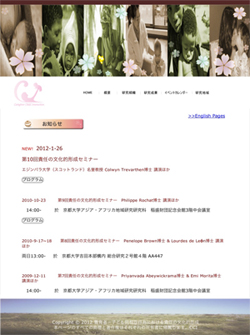要旨:第7回(2009・12・11開催)
1.Mariko Fujimoto(Kyoto Univ.)
A preliminary study of code-switching between Swahili and ethnic language in Tanzania: Evidences from conversational data among Tongwe people)
In Tanzania, there are about 120 ethnic languages which include national language Swahili and official language English. Swahili is used for education language in primary school, while most of people speak Swahili and their own ethnic language in their daily life. I have conducted field research in Kigoma region, Tanzania, among people who speak Tongwe as their first language. I analyzed their conversations using audio recorded data. As both Swahili and Tongwe belong to Northeast Bantu language in the Niger-Congo family and share many words, it is difficult to distinguish between Swahili and Tongwe languages only by the lexicon. Though analyzing their practices of conversation, however, we can recognize several contextual clues that the participants made a code switching between Swahili and Tongwe. Based on these findings, I will provide a perspective to study code-switching phenomenon between Swahili and other Bantu language.
2.Priyanvada Abeywickrama(San Francisco State Univ.)
Examining code switching in Sri Lanka: a discourse analytic approach
Sri Lanka has three languages, Sinhala, Tamil and English, and many Sri Lankans are bilingual. The focus of this talk is examining code switching between Sinhala and English. Code switching is not a display of a grammarless mixing of two languages, instead its users express a range of meanings. Research on code switching for many years has been along the sociolinguistic and grammatical lines. However, these two traditions leave a gap in code switching research. Macro-sociolinguistics cannot explain the complexity of language choice because analyses of local processes of language negotiation and code selection in speech events are focused around participants or topic or setting and not the place within the interactional episode in which languages alternate. Thus conversations should also be analyzed by looking for patterns of code switching between conversational moves or intonation units. While the expression code mixing is used synonymously with code switching, recent research defines it as using two languages where a third, new code emerges. Analyzing audio taped conversations among Sinhala/English bilinguals in Sri Lanka as well as in the US, a discourse analytic approach is used to explore the possibility that code switching in Sri Lanka is in transition to code mixing.
3.Emi Morita(Singapore National Univ.)
The Japanese Interactional Particle NE: A study of its use in conversational interaction
This study employs key concepts of Interactional Linguistics and Conversation Analysis in order to investigate how speakers of Japanese may deploy interactional particles as resources for talk-in-interaction. Particles such as ne, yo and sa appear primarily in spoken language, carrying neither referential nor denotational meaning, nor indicating grammatical relations. Fluency in such particle use is not easy for non-native speakers of Japanese to acquire, due to these particles’ various pragmatic effects, sociolinguistic implications, and multiple different possible interpretations. Yet, Japanese children at the 1.5 word stage seem to have no problem correctly using these particles. In the first part of my talk, I will discuss how these interactional particles appear in utterance initial, medial, and final positions, creating prosodically marked boundaries within a stretch of talk, and highlighting the interactional relevancy of certain units and the saliency of particular conversational moves. In the second part of my talk, I will discuss the specific conversational functions of the interactional particle ne. Previous studies have suggested the particle ne functions as a confirmation-agreement marker, as an indication of shared information, or as marker of rapport. Additionally, some scholars have associated the over-use of ne with Japanese “women’s talk.” What has emerged from the existing literature is rather a kaleidoscopic view of the particle ne, and thus there is as yet no comprehensive picture of this particle’s function in toto. The results of my research studying ne as it is actually used in the moment-to-moment unfolding of everyday talk suggests that ne contextualizes speakers’ displays of alignment as a relevant concern for the participants over the developing course of an ongoing interaction. Thus, despite the great variety of its secondary functions and purposes, ne’s underlying semantic efficacy in relation to the several particular uses of it found in my data is always to create an interactional moment for alignment, whenever such alignment suddenly becomes an issue. Concretely, it indicates the speakers’ cooperative stances for the coordinated functioning for ongoing action by making the other participants’ alignment as a relevant next action in the talk. In short, my study argues that the ubiquity of these particles in Japanese conversation suggests that such explicit displays of alignment are a ‘primordial’ part of human interaction. The fact that Japanese children acquire this particle quite early stage supports also such interactional particles’ pervasive importance as resources for the explicit marking of alignment in Japanese speakers’ everyday interactions.

